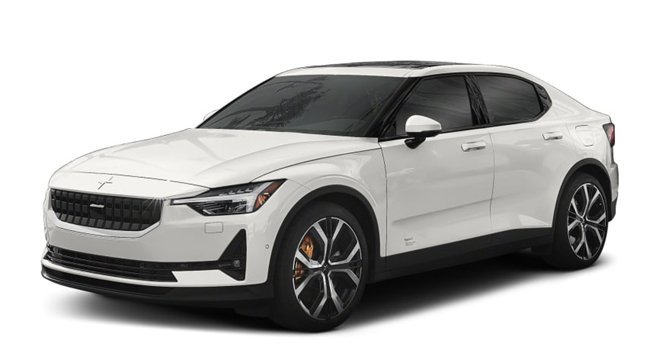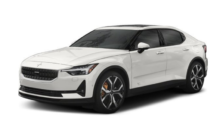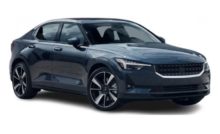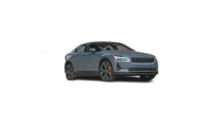Securing a convertible seat with a seat belt
Convertible seats can be used in either a forward or rearward-facing position, depending on the age and size of the child.
WARNING
Always use a convertible seat that is suitable for the child’s age and size. See the convertible seat manufacturer’s recommendations.
- Place the convertible seat in the rear seat of the vehicle.
WARNING
- A small child’s head represents a considerable part of its total weight and its neck is still very weak. Polestar recommends that children up to age 4 travel, properly restrained, facing rearward. In addition, Polestar recommends that children should ride facing rearward, properly restrained, as long as possible.
- Convertible child seats should be installed in the rear seat only.
- A rear-facing convertible seat should not be positioned behind the driver’s seat unless there is adequate space for safe installation.
- Attach the seat belt to the convertible seat according to the child restraint manufacturer’s instructions.
- Fasten the seat belt by inserting the latch plate into the buckle (lock) until a distinct click is audible.
- Pull the shoulder section of the seat belt out as far as possible to activate the belt’s automatic locking function.
NOTE
The locking retractor will automatically release when the seat belt is unbuckled and allowed to retract fully.
- Press the convertible seat firmly in place, let the seat belt retract and pull it taut. A sound from the seat belt retractor’s automatic locking function will be audible at this time and is normal. The seat belt should now be locked in place.
- Push and pull the convertible seat along the seat belt path to ensure that it is held securely in place by the seat belt.
WARNING
It should not be possible to move the child restraint more than 2.5 cm (1 in.) in any direction along the seat belt path.
The convertible seat can be removed by unbuckling the seat belt and letting it retract completely.
WARNING
A child seat should never be used in the front passenger seat of any vehicle with a front passenger airbag – not even if the “Passenger airbag off” symbol near the rear-view mirror is illuminated. If the severity of an accident were to cause the airbag to inflate, this could lead to serious injury or death to a child seated in this position.
Infant seats
Suitable child restraints should always be used when children (depending on their age/size) are seated in the vehicle.
Securing an infant seat with a seat belt
- Place the infant seat in the rear seat of the vehicle.
- Attach the seat belt to the infant seat according to the child restraint manufacturer’s instructions.Route the seat belt through the infant seat.
WARNING
- An infant seat must be in the rear-facing position only.
- The infant seat should not be positioned behind the driver’s seat unless there is adequate space for safe installation.
WARNING
A child seat should never be used in the front passenger seat of any vehicle with a front passenger airbag – not even if the “Passenger airbag off” symbol near the rear-view mirror is illuminated. If the severity of an accident were to cause the airbag to inflate, this could lead to serious injury or death to a child seated in this position.
- Pull the shoulder section of the seat belt out as far as possible to activate the belt’s automatic locking function.
NOTE
The locking retractor will automatically release when the seat belt is unbuckled and allowed to retract fully.
- Press the infant seat firmly in place, let the seat belt retract and pull it taut. A sound from the seat belt retractor’s automatic locking function will be audible at this time and is normal. The seat belt should now be locked in place.
- Press and pull the infant seat along the direction of the seat belt to check that it is properly held in place by the seat belt.
WARNING
It should not be possible to move the child restraint more than 2.5 cm (1 in.) in any direction along the seat belt path.
The infant seat can be removed by unbuckling the seat belt and letting it retract completely.
Occupant Classification System
The Occupant Classification System (OCS) is designed to meet the regulatory requirements of Federal Motor Vehicle Safety Standard (FMVSS) 208 and is designed to disable (will not inflate) the passenger’s side front airbag under certain conditions.
The front airbag on the passenger side is either activated or deactivated depending on the classification of the passenger in the front passenger seat.
Polestar follows NHTSA’s recommendations and recommends that ALL children up to age 12 sit in the rear seat and are secured appropriately for their height and height. This is very strongly recommended for children sitting in rear-facing child seats.
| Classification of passengers in the front passenger seat | OCS indicator light status | Passenger’s side front airbag status |
| The passenger is classified as an adult. | OCS indicator light is not lit. | Activated |
| The passenger is classified as a small child in a forward-facing child seat. | The OCS indicator light is lit or not lit depending on several parameters that determine the most suitable status. | Enabled or disabled depending on several parameters that determine the most suitable status. |
| The passenger is classified as a small child in a rear-facing child seat. | OCS indicator light is lit. | Deactivated |
| The passenger seat is empty. | OCS indicator light is lit. | Deactivated |
Occupant Classification System function
OCS works in combination with sensors in the front passenger seat. The sensors are designed to detect the presence of, and classify, a properly seated occupant and determine if the passenger’s side front airbag should be enabled (may inflate) or disabled (will not inflate).
The OCS uses an indicator lamp with the text PASSENGER AIRBAG OFF, which will illuminate and stay on to remind you that the passenger’s side front airbag is disabled. The indicator light with the text PASSENGER AIRBAG OFF is located in the ceiling console, near the bracket for the rearview mirror.
Always make sure that the indicator light status shows the correct classification, both before and while driving, when the front passenger seat is occupied.
NOTE
When the ignition is switched on, the OCS indicator light will illuminate for several seconds while the system performs a self-diagnostic test. The indicator light will then go out or remain illuminated, depending on the classification of the occupant of the front passenger seat.


If a malfunction is detected in the system, the OCS indicator light will remain illuminated and the SRS warning symbol will be shown in the instrument panel along with a text message.
WARNING
If a fault in the system is detected and indicated as described, be aware that the passenger’s side front airbag will not deploy in the event of a collision. In this case, have the airbag system and the Occupant Classification System checked by a workshop as soon as possible.






